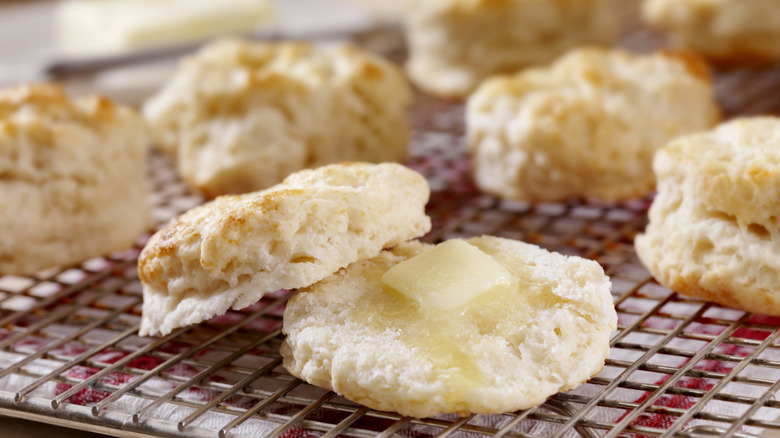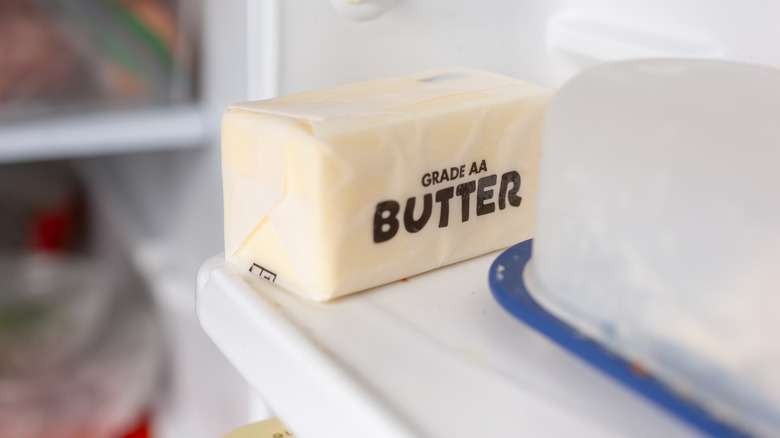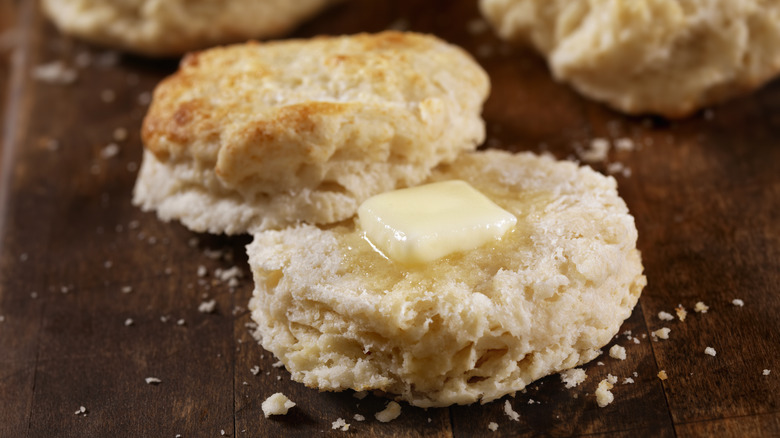Room Temperature Vs. Cold Butter: Which Is Better For Biscuits?
Biscuits are simple and tricky all in one. They usually consist of just a few ingredients: flour, a leavening agent, buttermilk or cream, and butter. And yet, if your biscuits aren't prepared properly, they'll turn out flat and tough rather than fluffy and soft. Each ingredient must be perfectly incorporated, and your dough can't be overworked if you want your pastries to turn out tasty and tender. One of the most important aspects of biscuit-making is butter temperature. Using the dairy product at the incorrect temperature can take your treats from wonderful to downright inedible.
So which is better for biscuits, warm butter or cold? Unlike some baking advice, which is tinged with asterisks and exceptions, for biscuits the guidance is universal: Use cold butter. It's the only way to go if you want flaky and delicious biscuits as it prevents the formation of gluten in your dough and helps to create pockets for steam formation to ensure a layered and tremendously tender result. This means they'll be easy to split open, revealing a crisp inside that is entirely unique to the traditionally Southern American treat. So next time you bake up a batch of biscuits, make sure to pop your butter in the fridge beforehand.
Keeping it cold
When you're preparing to make biscuits, make sure your butter is as cold as possible. Don't pull it out of the fridge until it's time to incorporate it into your flour mixture. Then, cut your butter into small pieces and use either your hands or a pastry blender to mix them with your flour, making sure to not overwork your dough. Of course, this method does leave room (and time) for the butter to melt into your dough, canceling out the benefits of using cold butter.
To keep your butter as cold as possible, pop a stick (or two) of your butter into the freezer overnight. This will keep it cool enough so that it's less likely to melt into your dough. However, freezing your butter can also make it more difficult to cut into smaller pieces. So instead of cutting it, use a box grater to break it down into small shreds. Using a box grater will also allow for a more even dough that will create a flaky, soft, and butter-rich biscuit. And if your butter has melted a bit in the dough-making process, you can always pop your uncooked biscuits into the fridge before baking. This will help harden your butter and loosen up the gluten within your dough, yielding a more tender final product.
The science of biscuits
Using cold butter in baking projects is nothing new. Other baked goods, such as croissants and pie doughs also require cold butter for lamination. This is the process by which butter is folded into dough repeatedly, forming layers that will turn into a flaky, buttery pastry once baked. And though most biscuits aren't laminated, the loose incorporation of butter into discrete pockets throughout the dough has a similar effect. Essentially, these clusters throughout biscuit or croissant dough begin to steam in the oven (thanks to the water content in butter). As the water turns to steam, pockets of air form, which turn into the layers — or "flakes" — within your baked goods. If your butter isn't cold, however, it will blend into your flour, and no air pockets will form. This will result in a flatter, denser, and tougher biscuit.
Using cold butter isn't the only key to a soft biscuit, however. Buttermilk, a popular ingredient in biscuits, is also a fantastic choice to help soften up your dough and, like cold butter, also acts as a slight leavening agent thanks to the fat and acid content. Buttermilk also has the added benefit of bringing a zing of flavor to your biscuits that might be lacking if you simply use cream. And using it along with frozen butter will help your treats reach new heights (while maintaining a soft center).


